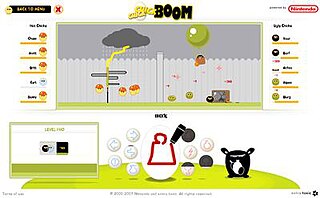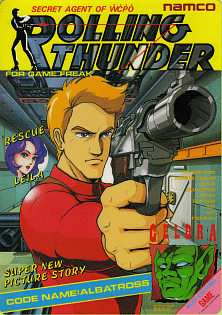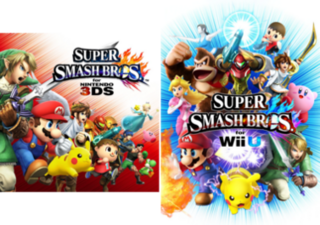Related Research Articles

Kid Icarus is a platform video game developed and published by Nintendo for the Family Computer Disk System in Japan and the Nintendo Entertainment System in Europe and North America. It was released in Japan in December 1986, in Europe in February 1987, and in North America in July.
Metroid is an action-adventure game franchise created by Nintendo. The player controls the bounty hunter Samus Aran, who protects the galaxy from Space Pirates and other malevolent forces and their attempts to harness the power of the parasitic Metroid creatures.

Donkey Kong Jr. is a 1982 arcade platform game that was released by Nintendo. It is the sequel to Donkey Kong, but with the roles reversed compared to its predecessor: Mario is now the villain and Donkey Kong Jr. is trying to save his kidnapped father. It first released in arcades and, over the course of the decade, was released for a variety of home platforms. The game's title is written out as Donkey Kong Junior in the North American arcade version and various conversions to non-Nintendo systems.
Pikmin is a real-time strategy and puzzle video game series created by Shigeru Miyamoto, and published by Nintendo. The games focus on directing a horde of plant-like creatures called Pikmin to collect items by destroying obstacles, avoiding hazards, and fighting fauna that are hazardous to both the player character and the Pikmin.
Star Wars: Rogue Squadron is a series of Star Wars action video games jointly developed by LucasArts and Factor 5 and published by LucasArts for Nintendo consoles. Aspyr has expressed interest in bringing the series to the Nintendo Switch.
Super Smash Bros. is a crossover platform fighting game series published by Nintendo. The series was created by Masahiro Sakurai, who has directed every game in the series. The series is known for its unique gameplay objective which differs from that of traditional fighters, in that the aim is to increase damage counters and knock opponents off the stage instead of depleting life bars.
The Virtual Console is a defunct line of downloadable video games for Nintendo's Wii and Wii U home video game consoles and the Nintendo 3DS family of systems.

Excite Truck is a racing video game developed by Nintendo and Monster Games and published by Nintendo for the Wii. It features malleable environments and tilt-based controls. The game was one of the Wii launch titles in North America. It is the third main game in the Excite series and the first to feature vehicles other than motorbikes.

Wii Music is a music video game developed and published by Nintendo for the Wii video game console. The game was released in Japan and North America in October 2008, and in Europe and Australia in the following month. Wii Music is part of both Nintendo's Touch! Generations brand and the Wii series.

Chick Chick Boom is an online Adobe Flash game created for Easter 2007 by German developer Extra Toxic and sponsored by Nintendo of Europe. The two companies had previously cooperated in a similar project called UPIXO In Action: Mission in Snowdriftland. The game launched on April 3, 2007 and was only playable through the month of April. After Extra Toxic took the game offline on April 30, 2007, a new version presenting new features and 3D visuals, was released on Q4 2010 for the Wii as a downloadable game for the WiiWare service.

Bit.Trip, stylized BIT.TRIP, is a series of nine video games developed by Choice Provisions and published by Aksys Games for the Wii, Nintendo 3DS, Microsoft Windows, macOS, PS Vita, and PS4. It was published by Arc System Works for WiiWare and Nintendo eShop in Japan, and by Namco Networks America Inc for the iPhone, iPod Touch and iPad. Each game revolves around the adventures of a character named "Commander Video", and features "a crazy mix of 80s aesthetics and modern game design". The styles of the games range from pong-like, to platforming, and shooting. Each game in the series features a chiptune-inspired soundtrack, but a different style of rhythm-based gameplay in each. Most games in the series have few levels; Beat, Core, Void and Flux have only three levels each while Fate has six and Runner has 36. Most of the games feature levels lasting between 10 and 25 minutes to make up for having such few levels. The games also consists of 8 modes; Nether, Hyper, Mega, Super, Ultra, Extra, Giga, and Meta; which changes based on how well the player does. Each successive game adds a new mode, the highest being Mega in Beat, and Meta in Flux.

New Super Mario Bros. Wii is a 2009 platform game developed and published by Nintendo for the Wii. A follow-up to New Super Mario Bros., it was first released in Australia, North America, and Europe in November 2009, followed by Japan a month later. A high-definition port for the Nvidia Shield TV was released in China in December 2017. Like other side-scrolling Super Mario games, the player controls Mario as he travels eight worlds and fights Bowser's henchmen to rescue Princess Peach. New Super Mario Bros. Wii was the first Super Mario game to feature simultaneous cooperative multiplayer gameplay; up to four people can play in cooperative and competitive multiplayer modes, taking control of Mario as well as Luigi and one of two multicolored Toads. The game also introduces "Super Guide", which allows the player to watch a computer-controlled character complete a level.

Rolling Thunder is a run and gun video game developed by Namco in Japan and Europe and released in 1986 as a coin-operated arcade video game using the Namco System 86 hardware. It was distributed in North America by Atari Games. The player takes control of a secret agent who must rescue his female partner from a terrorist organization. Rolling Thunder was a commercial success in arcades, and it was released for various home computer platforms in 1987 and the Nintendo Entertainment System in 1989. The original arcade game has been included in various classic game compilations as well. It influenced later arcade action franchises such as Shinobi and Time Crisis, which borrowed mechanics such as taking cover behind crates.

Super Smash Bros. for Nintendo 3DS and Super Smash Bros. for Wii U, both commonly referred together as Super Smash Bros. 4, are 2014 crossover platform fighter video games developed by Bandai Namco Studios and Sora Ltd. and published by Nintendo for the Nintendo 3DS and Wii U video game consoles. It is the fourth installment in the Super Smash Bros. series, succeeding Super Smash Bros. Brawl. The Nintendo 3DS version was released in Japan on September 13, 2014, and in North America, Europe, and Australia the following month. The Wii U version was released in North America, Europe, and Australia in November 2014 and in Japan the following month.
The Nintendo Network is Nintendo's online service which provides free online functionality for the Nintendo 3DS and Wii U systems and their compatible games. Announced on January 26, 2012, at an investors' conference, it is Nintendo's second online service after Nintendo Wi-Fi Connection. Former president of Nintendo Satoru Iwata said, "Unlike Nintendo Wi-Fi Connection, which has been focused upon specific functionalities and concepts, we are aiming to establish a platform where various services available through the network for our consumers shall be connected via Nintendo Network service so that the company can make comprehensive proposals to consumers."

Bayonetta 2 is a 2014 action-adventure hack and slash video game developed by PlatinumGames and published by Nintendo. It is the sequel to the 2009 game Bayonetta, and was directed by Yusuke Hashimoto and produced by Atsushi Inaba, Akiko Kuroda, and Hitoshi Yamagami, under supervision by series creator Hideki Kamiya.

Young Justice: Legacy is an action-adventure video game developed by Freedom Factory Studios and published by Little Orbit. It was released in November 2013 for Nintendo 3DS, Microsoft Windows, PlayStation 3, and Xbox 360. The game is based on the Young Justice animated television series, and takes place in the five-year gap between seasons one and two, and was developed in collaboration with the writers of the series, Greg Weisman and Brandon Vietti. Originally the game was planned to also be released on Nintendo DS, Wii, and Wii U, but the developers announced that these versions were cancelled due to quality issues and low interest from retailers.
The Nintendo data leak, also known as the Nintendo Gigaleak, is a series of leaks of data from the Japanese video game company Nintendo on the anonymous imageboard website 4chan. The leak started in March 2018, but became most prominent in 2020. Ten main sets of data leaked on 4chan, ranging from game and console source code to internal documentation and development tools. The name "Gigaleak" mainly refers to the second leak on July 24, 2020, which was 3 gigabytes in size. The leaks are believed to have come from companies contracted by Nintendo in the design of these consoles, and/or from individuals previously convicted of intrusion into Nintendo systems. An earlier, much smaller leak had also occurred in 2018 which contained the Nintendo Space World 1997 demos for Pokémon Gold and Silver.
References
- ↑ "tons of bits". Twitter. Retrieved 26 December 2020.
- ↑ "extra toxic - online entertainment". www.extratoxic.com. Retrieved 26 December 2020.
- 1 2 "Spotlight on Indie Issue #3: Interview with Indie Game Developer tons of bits". www.alteredgamer.com. 27 January 2011. Retrieved 26 December 2020.
- ↑ Robinson, Nick (December 24, 2020). Mission in Snowdriftland: Nintendo's forgotten Flash game (video). Event occurs at 21:00. Retrieved October 19, 2021– via YouTube.
But actually, it's password-protected as far as I know.
- ↑ van Duyn, Marcel (26 November 2010). "Mission in Snowdriftland Returns this December". Nintendo Life. Retrieved 26 December 2020.
- ↑ Robinson, Nick (December 24, 2020). Mission in Snowdriftland: Nintendo's forgotten Flash game (video). Retrieved October 19, 2021– via YouTube.